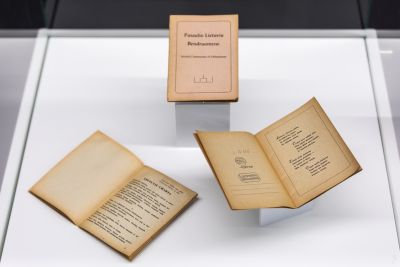On June 14, 1949 in Augsburg, Germany, Lithuania’s Supreme Liberation Committee published a pocket-size book World Community of Lithuanians (Dr. Haas & Cie., KG., Augsburg), also known as the Lithuanian Charter. The document laid the foundations of the Lithuanian World Community, Inc., brought together and provided the new meaning to thousands of Lithuanian war refugees.
The Lithuanian Charter empowered Lithuanians, who after WWII once again found themselves homeless, to continue to fight for Lithuania’s independence and to strive to maintain at all costs not only the family and kinship, but also the national connection, so that “each countryman met abroad [would] be like brother.”

The Lithuanian Charter is exhibited at the National Library of Lithuania.
The publication of the Lithuanian Charter was Committee’s response to the rapidly changing situation of Lithuanian war refugees in post-war Germany and the future full of anxiety and uncertainty. At the end of the war, it became clear that Lithuania would not regain its independence yet, therefore many refugees decided to take advantage of the opportunity to immigrate to Canada, Australia, the United States and other countries not affected by war. Prelate Mykolas Krupavičius, the chairman of the Committee, and other members of the organization decided to establish a Lithuanian community in each country and create one united Lithuanian community abroad.
The actual Lithuanian World Community, Inc. was founded in 1951. That year, the LWC Interim Organizing Committee was established. A few years later, in 1958, in New York, the Seimas provided guidelines and structure for the new organization, elected its leadership, and passed the main document— the LWC Constitution, which is still used today without any major changes.
The LWC unites all Lithuanian communities operating in different countries. Any person, who is Lithuanian, can be its member. Krupavičius, who initiated the idea of the LWC and wrote about it in the book The Road of the Lithuanian World Community, stated that “[t]he LWC has two goals: fundamental and random. The fundamental goal is to keep Lithuaniannes and the random goal is to regain freedom for Lithuania.” These goals have been pursued throughout the entire history of the LWC.
Despite historic ups and downs and the internal changes within the Lithuanian communities abroad, the Lithuanian Charter still serves as a moral cause for many Lithuanians living abroad. It’s a trusted advisor and a pillar for old and new Lithuanian communities in the world.